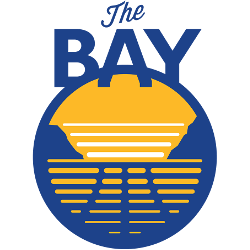For the first time in nearly 50 years, the Golden State Warriors will be playing their home schedule in the city of San Francisco. The brand-new Chase Center opens its doors this fall, and the five-time defending NBA Western Conference champions will mark the move with a new logo and new uniforms.

Golden State Warriors Primary Logo 2020 - Present
The new logo features a darker blue and a more detailed Bay Bridge, highlighting the team’s connection to its new town — San Francisco — and their old digs in Oakland. The bridge itself and a circle outline is also more of a gold color instead of the yellow that was previously used.
The font used for “Golden State” above the circle and “Warriors” below it has also been updated.
The Warriors also added two new alternate logos to their arsenal. One is the same blue circle with a blue and gold “W” in it. This replaces an existing alternate logo with a white “W.” Also, new this season will be an alternate logo called The Bay. It features a circle with two landmasses and an open area between it, with a sunrise look. The lower half of the circle has a basketball silhouette and represents the water that connects Oakland and San Francisco. The Bay logo will also be featured on alternate jerseys this season, to go with the existing ones featuring The Town and The City.
A couple of alternate logos are biting the dust with this change. The alternate logo with a “W” in front of the state of California is history, along with a circular logo that has the letters "SF" in it and “Est. 1962” beneath the circle.

Golden State Warriors Alternate Logo 2020 - Present
The primary logo change isn’t as radical as the one in 2010 when the 13-year run of their gladiator-style mascot came to an end. That era of Warriors basketball isn’t known for much — two things that come to mind are Latrell Sprewell choking then-head coach P.J. Carlesimo and Baron Davis leading the Warriors to a first-round playoff win over Dallas in 2007, which was the first-ever upset of a No. 8 seed against a No. 1 seed in a seven-game series.
The team was known as the San Francisco Warriors upon its move from Philadelphia in 1962, and it featured an Indian headdress as a logo until 1969. The franchise used “The City” logo for two seasons, before moving to Oakland and going to the look that it would have for 25 years. It started with a yellow circle with the state of California in it, and a star marking the Bay Area. In 1975, coming off the franchise’s first NBA championship, lines were added so the circle would resemble a basketball. The font of “Golden State” and “Warriors” surrounding the circle changed in 1988, but this look remained through the Chris Mullin years until the massive overhaul to the armored figure gripping a lightning bolt in 1997.
A year after transforming the franchise by drafting Stephen Curry, the club changed the logo in 2010 to the one made famous by the current incarnation of the team winning three NBA titles. After hiring Steve Kerr prior to the 2014-15 NBA season, the Warriors would go on to enjoy their most prosperous period in franchise history. Kerr had led the Warriors to the NBA Finals in each of his five seasons as coach, winning the championship three times. The 2010-19 Warriors logo will go down as one of the most recognized in league history, as four Warriors were among the top 15 in NBA jersey sales in 2018 – Stephen Curry (No. 1), Kevin Durant (No. 4), Klay Thompson (No. 10), and Draymond Green (No. 13).
A new era of Warriors basketball will be ushered in this fall without Durant (who left for the Brooklyn Nets) and Thompson (who will be coming off surgery to repair a torn ACL suffered in the 2019 NBA Finals), along with a new logo, uniforms, arena, and home town.
See the Golden State Warriors logo history and team history.
Sports Logo History is a community of sports logo enthusiast who enjoys the history of each team’s logo history. Sports Logo History has primary logos, alternate logos, wordmark logos or concept logos from the NFL, NBA, MLB, MLS, NHL, Premier League, WNBA, CFL, NCAA, ABA, USFL, AAF, and XFL.
Our partner site is Sports Team History takes a look at the history of each and every professional sports team.

